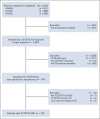Prognostic Value of FLT3-Internal Tandem Duplication Residual Disease in Acute Myeloid Leukemia
- PMID: 36315929
- PMCID: PMC9901965
- DOI: 10.1200/JCO.22.00715
Prognostic Value of FLT3-Internal Tandem Duplication Residual Disease in Acute Myeloid Leukemia
Abstract
Purpose: The applicability of FLT3-internal tandem duplications (FLT3-ITD) for assessing measurable residual disease (MRD) in acute myeloid leukemia (AML) in complete remission (CR) has been hampered by patient-specific duplications and potential instability of FLT3-ITD during relapse. Here, we comprehensively investigated the impact of next-generation sequencing (NGS)-based FLT3-ITD MRD detection on treatment outcome in a cohort of patients with newly diagnosed AML in relation to established prognostic factors at diagnosis and other MRD measurements, ie, mutant NPM1 and multiparameter flow cytometry.
Methods: In 161 patients with de novo FLT3-ITD AML, NGS was performed at diagnosis and in CR after intensive remission induction treatment. FLT3-ITD MRD status was correlated with the cumulative incidence of relapse and overall survival (OS).
Results: NGS-based FLT3-ITD MRD was present in 47 of 161 (29%) patients with AML. Presence of FLT3-ITD MRD was associated with increased risk of relapse (4-year cumulative incidence of relapse, 75% FLT3-ITD MRD v 33% no FLT3-ITD MRD; P < .001) and inferior OS (4-year OS, 31% FLT3-ITD MRD v 57% no FLT3-ITD MRD; P < .001). In multivariate analysis, detection of FLT3-ITD MRD in CR confers independent prognostic significance for relapse (hazard ratio, 3.55; P < .001) and OS (hazard ratio 2.51; P = .002). Strikingly, FLT3-ITD MRD exceeds the prognostic value of most generally accepted clinical and molecular prognostic factors, including the FLT3-ITD allelic ratio at diagnosis and MRD assessment by NGS-based mutant NPM1 detection or multiparameter flow cytometry.
Conclusion: NGS-based detection of FLT3-ITD MRD in CR identifies patients with AML with profound risk of relapse and death that outcompetes the significance of most established prognostic factors at diagnosis and during therapy, and furnishes support for FLT3-ITD as a clinically relevant biomarker for dynamic disease risk assessment in AML.
Conflict of interest statement
No other potential conflicts of interest were reported.
Figures




References
Publication types
MeSH terms
Substances
LinkOut - more resources
Full Text Sources
Miscellaneous

